The study of galaxy formation and evolution is concerned with the processes that formed a heterogeneous universe from a homogeneous beginning, the formation of the first galaxies, the way galaxies change over time, and the processes that have generated the variety of structures observed in nearby galaxies. Galaxy formation is hypothesized to occur from structure formation theories, as a result of tiny quantum fluctuations in the aftermath of the Big Bang. The simplest model in general agreement with observed phenomena is the Lambda-CDM model—that is, that clustering and merging allows galaxies to accumulate mass, determining both their shape and structure. Hydrodynamics simulation, which simulates both baryons and dark matter, is widely used to study galaxy formation and evolution.

A quasar is an extremely luminous active galactic nucleus (AGN). It is sometimes known as a quasi-stellar object, abbreviated QSO. The emission from an AGN is powered by a supermassive black hole with a mass ranging from millions to tens of billions of solar masses, surrounded by a gaseous accretion disc. Gas in the disc falling towards the black hole heats up because of friction and releases energy in the form of electromagnetic radiation. The radiant energy of quasars is enormous; the most powerful quasars have luminosities thousands of times greater than that of a galaxy such as the Milky Way. Usually, quasars are categorized as a subclass of the more general category of AGN. The redshifts of quasars are of cosmological origin.
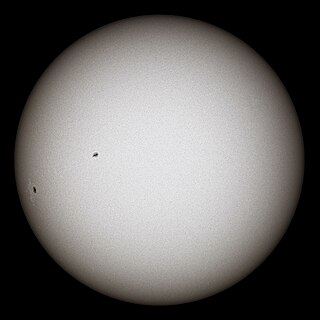
A star is an astronomical object comprising a luminous spheroid of plasma held together by self-gravity. The nearest star to Earth is the Sun, center of the solar system. Many other stars are visible to the naked eye at night, but their immense distances from Earth make them appear as fixed points of light. The most prominent stars have been categorised into constellations and asterisms, and many of the brightest stars have proper names. Astronomers have assembled star catalogues that identify the known stars and provide standardized stellar designations. The observable universe contains an estimated 1022 to 1024 stars. Only about 4,000 of these stars are visible to the naked eye, all within the Milky Way galaxy.
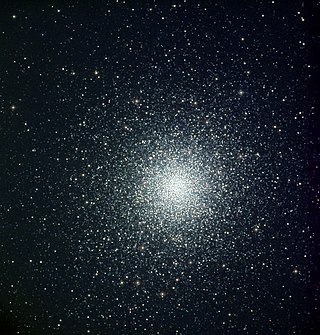
Star clusters are large groups of stars held together by self-gravitation. Two main types of star clusters can be distinguished: globular clusters are tight groups of ten thousand to millions of old stars which are gravitationally bound, while open clusters are more loosely clustered groups of stars, generally containing fewer than a few hundred members, and are often very young. Open clusters become disrupted over time by the gravitational influence of giant molecular clouds as they move through the galaxy, but cluster members will continue to move in broadly the same direction through space even though they are no longer gravitationally bound; they are then known as a stellar association, sometimes also referred to as a moving group.

Star formation is the process by which dense regions within molecular clouds in interstellar space, sometimes referred to as "stellar nurseries" or "star-forming regions", collapse and form stars. As a branch of astronomy, star formation includes the study of the interstellar medium (ISM) and giant molecular clouds (GMC) as precursors to the star formation process, and the study of protostars and young stellar objects as its immediate products. It is closely related to planet formation, another branch of astronomy. Star formation theory, as well as accounting for the formation of a single star, must also account for the statistics of binary stars and the initial mass function. Most stars do not form in isolation but as part of a group of stars referred as star clusters or stellar associations.
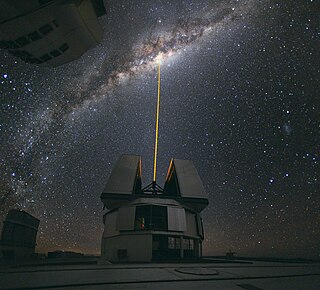
Astronomy is a natural science that studies celestial objects and phenomena. It uses mathematics, physics, and chemistry in order to explain their origin and evolution. Objects of interest include planets, moons, stars, nebulae, galaxies, meteoroid, asteroid, and comets. Relevant phenomena include supernova explosions, gamma ray bursts, quasars, blazars, pulsars, and cosmic microwave background radiation. More generally, astronomy studies everything that originates beyond Earth's atmosphere. Cosmology is a branch of astronomy that studies the universe as a whole.

In astronomy, a contact binary is a binary star system whose component stars are so close that they touch each other or have merged to share their gaseous envelopes. A binary system whose stars share an envelope may also be called an overcontact binary. The term "contact binary" was introduced by astronomer Gerard Kuiper in 1941. Almost all known contact binary systems are eclipsing binaries; eclipsing contact binaries are known as W Ursae Majoris variables, after their type star, W Ursae Majoris.

An astronomical object, celestial object, stellar object or heavenly body is a naturally occurring physical entity, association, or structure that exists within the observable universe. In astronomy, the terms object and body are often used interchangeably. However, an astronomical body or celestial body is a single, tightly bound, contiguous entity, while an astronomical or celestial object is a complex, less cohesively bound structure, which may consist of multiple bodies or even other objects with substructures.

Astrophysics is a science that employs the methods and principles of physics and chemistry in the study of astronomical objects and phenomena. As one of the founders of the discipline, James Keeler, said, Astrophysics "seeks to ascertain the nature of the heavenly bodies, rather than their positions or motions in space–what they are, rather than where they are." Among the subjects studied are the Sun, other stars, galaxies, extrasolar planets, the interstellar medium and the cosmic microwave background. Emissions from these objects are examined across all parts of the electromagnetic spectrum, and the properties examined include luminosity, density, temperature, and chemical composition. Because astrophysics is a very broad subject, astrophysicists apply concepts and methods from many disciplines of physics, including classical mechanics, electromagnetism, statistical mechanics, thermodynamics, quantum mechanics, relativity, nuclear and particle physics, and atomic and molecular physics.
Jesse Leonard Greenstein was an American astronomer. His parents were Maurice G. and Leah Feingold.

Donald Lynden-Bell CBE FRS was a British theoretical astrophysicist. He was the first to determine that galaxies contain supermassive black holes at their centres, and that such black holes power quasars. Lynden-Bell was President of the Royal Astronomical Society (1985–1987) and received numerous awards for his work, including the inaugural Kavli Prize for Astrophysics. He worked at the University of Cambridge for his entire career, where he was the first director of its Institute of Astronomy.

The following outline is provided as an overview of and topical guide to astronomy:
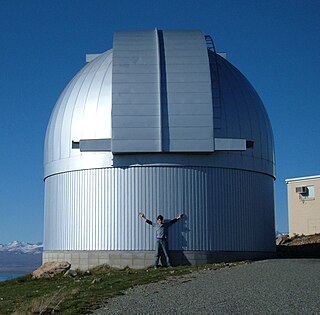
Microlensing Observations in Astrophysics (MOA) is a collaborative project between researchers in New Zealand and Japan, led by Professor Yasushi Muraki of Nagoya University. They use microlensing to observe dark matter, extra-solar planets, and stellar atmospheres from the Southern Hemisphere. The group concentrates especially on the detection and observation of gravitational microlensing events of high magnification, of order 100 or more, as these provide the greatest sensitivity to extrasolar planets. They work with other groups in Australia, the United States and elsewhere. Observations are conducted at New Zealand's Mt. John University Observatory using a 1.8 m (70.9 in) reflector telescope built for the project.
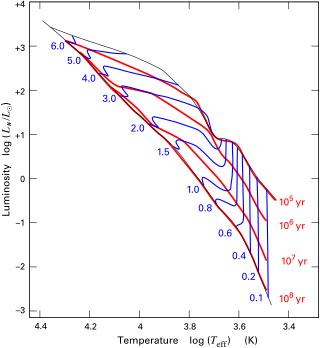
The Henyey track is a path taken by pre-main-sequence stars with masses greater than 0.5 solar masses in the Hertzsprung–Russell diagram after the end of the Hayashi track. The astronomer Louis G. Henyey and his colleagues in the 1950s showed that the pre-main-sequence star can remain in radiative equilibrium throughout some period of its contraction to the main sequence.
David Roy Merritt is an American astrophysicist.
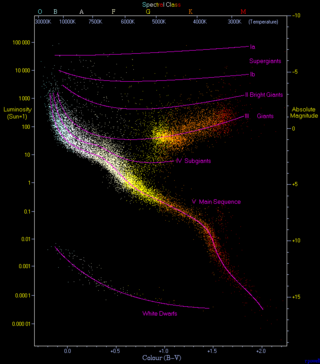
The Hertzsprung–Russell diagram is a scatter plot of stars showing the relationship between the stars' absolute magnitudes or luminosities versus their stellar classifications or effective temperatures. The diagram was created independently in 1911 by Ejnar Hertzsprung and by Henry Norris Russell in 1913, and represented a major step towards an understanding of stellar evolution.
Hyron Spinrad was an American astronomer. His research has ranged from the study of planet atmospheres to the evolution of galaxies. From 2010 until his death in late 2015 he was an emeritus professor of astronomy at the University of California, Berkeley.
This glossary of astronomy is a list of definitions of terms and concepts relevant to astronomy and cosmology, their sub-disciplines, and related fields. Astronomy is concerned with the study of celestial objects and phenomena that originate outside the atmosphere of Earth. The field of astronomy features an extensive vocabulary and a significant amount of jargon.













